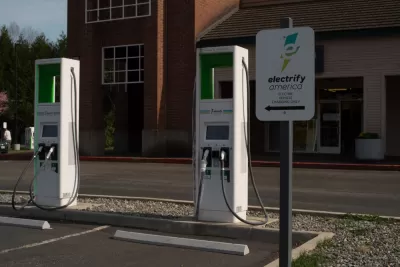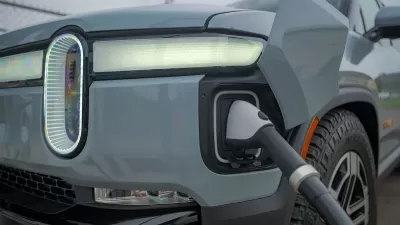Volkswagen-owned Electrify America plans to make its new charging stations more user-friendly with solar panel awnings and waiting lounges.

"Charging an electric car isn’t as straightforward as refilling a gas tank. Recharging times can vary depending on the vehicle type and power source. Battery experts claim that charging times will eventually shrink to around 10 minutes, but not for years to come."
To improve the experience, writes Andrew J. Hawkins in The Verge, Volkswagen's Electrify America charging company "aims to make charging as comfortable and seamless as possible" by installing "human-centered stations" in several California cities and New York. The stations will feature awnings with solar panels and a waiting area.
"The company’s new stations are organized around comfort, security, and amenities, with a nod toward the length of time it takes to recharge an EV," according to Hawkins. "The most notable change for Electrify America’s current design is the inclusion of solar panel awnings, which have the dual effect of sheltering customers from the sun and inclement weather while also supplying power for the station’s operations."
As Hawkins writes, "The charging experience in the US is extremely fragmented, especially for people who don’t own a Tesla. While Tesla’s Supercharger network has been praised for its seamless user experience and fast charging ability, the opposite appears to be true for pretty much everyone else." But EV proponents see hope in the Biden administration's $5 billion investment in EV chargers. "Experts in urban policy and electrification have said that the money authorized for a nationwide network of EV chargers would have a measurable impact on Americans’ car-buying choices," making it possible for more Americans to make the switch.
FULL STORY: VW’s Electrify America unveils new ‘human-centered’ EV charging stations

Manufactured Crisis: Losing the Nation’s Largest Source of Unsubsidized Affordable Housing
Manufactured housing communities have long been an affordable housing option for millions of people living in the U.S., but that affordability is disappearing rapidly. How did we get here?

Americans May Be Stuck — But Why?
Americans are moving a lot less than they once did, and that is a problem. While Yoni Applebaum, in his highly-publicized article Stuck, gets the reasons badly wrong, it's still important to ask: why are we moving so much less than before?

Using Old Oil and Gas Wells for Green Energy Storage
Penn State researchers have found that repurposing abandoned oil and gas wells for geothermal-assisted compressed-air energy storage can boost efficiency, reduce environmental risks, and support clean energy and job transitions.

Minneapolis Bans Rent-Setting Software
Four cities have enacted restrictions on algorithmic software that can inflate rent costs.

Oakland to Add 244 New EV Chargers
Oakland plans to launch its new charging network at eight locations by the end of 2025.

Jane Goodall Inspires with Message of Hope, Resilience, and Environmental Action
Speaking in Pasadena, Jane Goodall offered a hopeful and inspirational message, urging global compassion, environmental responsibility, and the power of individual action to shape a better future.
Urban Design for Planners 1: Software Tools
This six-course series explores essential urban design concepts using open source software and equips planners with the tools they need to participate fully in the urban design process.
Planning for Universal Design
Learn the tools for implementing Universal Design in planning regulations.
Heyer Gruel & Associates PA
City of Moreno Valley
Institute for Housing and Urban Development Studies (IHS)
City of Grandview
Harvard GSD Executive Education
Salt Lake City
NYU Wagner Graduate School of Public Service
City of Cambridge, Maryland





























